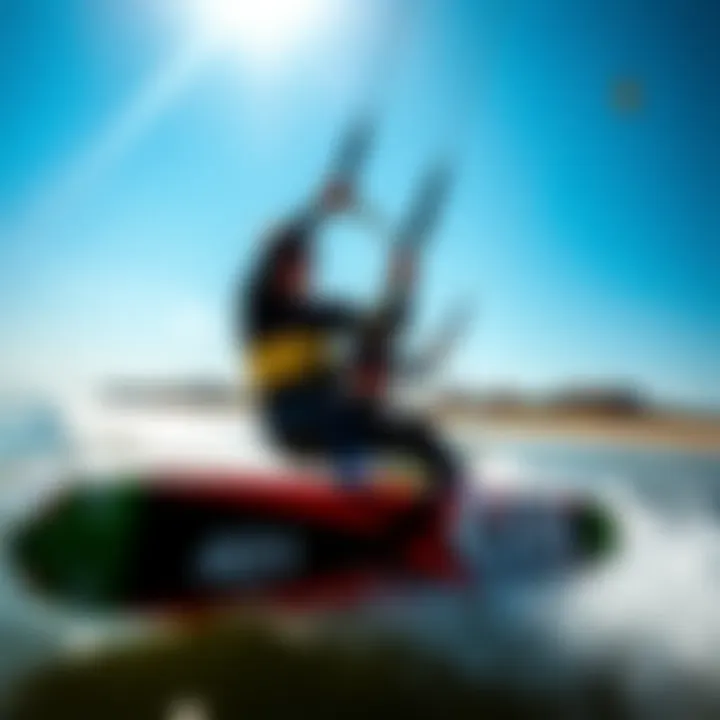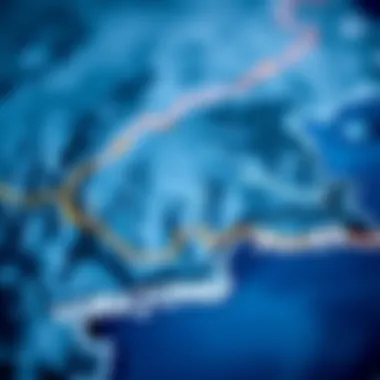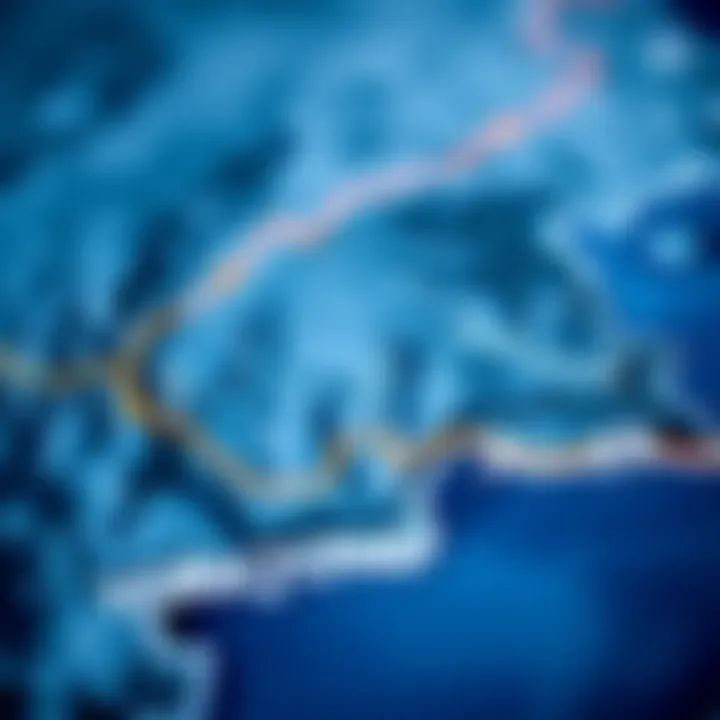Understanding Weather Radar in Yorktown, VA


Intro
Weather radar technology serves as the eyes in the sky, guiding many activities in Yorktown, Virginia, particularly those interested in kiteboarding. Radar systems analyze atmospheric conditions to provide accurate forecasts essential for various outdoor pursuits. In this region, meteorological nuances play a critical role in determining when it's suitable to get on a board and take advantage of those breezy days on the water.
Understanding the intricacies of this technology not only benefits kiteboard enthusiasts but also sheds light on the local climate. Those eager to learn how radar operates here will uncover insights that go beyond mere forecasting; they will discover how weather data shapes experiences on the water. Kiteboarding, beloved for its blend of excitement and skill, largely hinges on conducive weather. Hence, understanding the tools at our disposal to predict that weather becomes pivotal for both amateurs and experts.
Navigating through this guide, we invite readers to explore the specific features of Yorktown's radar systems, compare them with neighboring areas, and grasp how this technology dramatically influences local kiteboarding. This comprehensive overview aims to provide practical knowledge that can be utilized whether you're just starting out or have been riding the wind for years.
Gear Insights
The realm of kiteboarding doesn’t just hinge on winds and waves; equipment selection is just as crucial to a successful day on the water. Let's get into some of the latest gear available, along with what beginners should look for when shopping for their first kiteboarding setup.
Latest Gear Reviews
As kiteboarding evolves, so do the tools of the trade. Brands like Slingshot, Duotone, and Naish have recently introduced gear that emphasizes durability and performance. Interested individuals can benefit from checking out resources like Kitefinder that provide comprehensive reviews and comparisons.
- Slingshot Solo Kite: Known for its great stability and user-friendly handling, ideal for beginners.
- Duotone Evo: A versatile kite that adapts well to different wind conditions.
- Naish Motion Board: This board provides a fine balance between speed and maneuverability, perfect for those learning advanced tricks.
Essential Gear for Beginners
Getting started in kiteboarding requires a few basic items. Here’s a list to help kick off the journey:
- Kite: A dependable, easy-to-handle kite that is suitable for various conditions.
- Control Bar: Crucial for steering the kite, with safety features that ensure easy release and control.
- Harness: Comfort and fit are key; invest in a harness that provides support while you’re out riding.
- Board: Consider a beginner-friendly board that is wider to offer balance and stability.
Having the right gear is often the difference between frustration and fun. Ensure that what you choose maps well with your skill level and the weather conditions forecasted in Yorktown. Knowing what tools work best in conjunction with radar data can make all the difference in planning a day on the water.
Techniques and Tips
With the right gear in hand, the next step involves mastering the skills to ride. Let's look at some advanced techniques and invaluable safety practices that should be on every kiteboarder’s checklist.
Advanced Tricks and Techniques
As riders evolve, so does the desire to learn new tricks. Some popular advanced techniques include:
- Backroll: A rotation trick where the kite guides the board around.
- Jumping: Learning to jump higher requires understanding wind patterns, often analyzed through radar.
- Kiteloops: An impressive maneuver combining speed and skill that attracts attention on the water.
Success with these tricks often comes down to timing related to weather conditions, showing just how intertwined radar data is with performance.
Safety Practices for Kiteboarders
Safety is paramount in kiteboarding. Follow these guidelines to ensure that every outing remains enjoyable:
- Check Weather Reports: Utilizing local radar and forecasts to craft a plan.
- Equipment Checks: Regular inspections of kites and boards to prevent malfunctions.
- Buddy System: Always kite with a partner to enhance safety on the water.
The confluence of radar data and practical knowledge uniquely equips kiteboarders in Yorktown. A deeper appreciation of weather dynamics will transform how enthusiasts approach their sessions.
Understanding local weather patterns is not just an academic exercise but a practical tool that can significantly enhance your kiteboarding experience and safety.
As kiteboarding continues to thrive along the shores of Yorktown, integrating a thorough understanding of radar technology ensures that hobbyists and instructors can fully leverage weather conditions for maximum enjoyment.
Prolusion to Weather Radar
Weather radar plays a crucial role in modern meteorology, and its significance is especially pronounced in areas like Yorktown, Virginia. The explanation isn’t just about detecting rain or identifying clear skies; it's much broader and fundamentally tied to the safety and planning of outdoor activities, kiteboarding being a particularly impacted sport in this region.
In simple terms, weather radar detects precipitation, measures its intensity, and identifies its movement. This technology can provide real-time data, enabling local meteorological services to forecast weather conditions accurately. For kiteboarders, understanding and accessing this information can mean the difference between an exhilarating day out on the water and a dangerous encounter with sudden storms.
Key Elements of Weather Radar
- Operational Efficiency: Radar systems have evolved significantly, enhancing the ability to predict localized weather patterns. This operational efficiency ensures a reliable source of weather data.
- Timeliness: The importance of timely updates cannot be overstated, especially for kiteboarders who need to adapt plans based on sudden changes in wind speed or direction.
- Granularity of Data: Advanced radar systems offer detailed imagery that can drill down to the level of microclimates, providing invaluable insights into small-scale weather phenomena.
"Weather radar not only serves as a tool for prediction but also as a bridge between the natural world and human activity, especially for those who thrive on adventure."
Benefits of Understanding Weather Radar
- Enhanced Safety: Knowing when and where storms are brewing helps enthusiasts keep their adventures safe and enjoyable.
- Improved Decision Making: Access to real-time weather conditions assists kiteboarders in making informed decisions, whether to venture out or stay on land.
- Community Preparedness: For instructors and hobbyists alike, being well-versed in radar data fosters a more prepared community that can respond collectively to weather threats.
The Science Behind Radar Technology
Understanding how radar technology works forms the backbone of any comprehensive discussion regarding weather systems. Radar has a transformative role, offering profound accuracy and reach in weather forecasting. It helps meteorologists pinpoint the exact behavior of atmospheric phenomena, which is particularly beneficial for locals in Yorktown, Virginia, where kiteboarding enthusiasts rely heavily on precise weather data for their activities.
How Radar Works


Basic Principles of Radar
The crux of radar technology begins with its basic principles, which revolve around sending out radio waves to detect objects and phenomena in the atmosphere. By transmitting pulses of energy and measuring the time it takes for these waves to bounce back, radar systems can calculate the distance to precipitation and other weather features.
An essential characteristic of these basic principles is their ability to provide real-time information, which is invaluable for timely decision-making. For example, local kiteboarders can benefit immensely when they receive instant updates about incoming storms, allowing them to avoid potentially hazardous situations on the water.
Furthermore, one notable feature is the ability to determine an object’s speed through the Doppler effect, which aids in understanding wind dynamics. However, limitations exist; radar systems may struggle to detect very light precipitation, affecting the accuracy during times of low-intensity showers.
Radio Waves and Reflectivity
Delving deeper, radio waves play a crucial role in radar operation. These waves travel at the speed of light and reflect off various objects, most notably raindrops. The reflectivity strength is directly correlated to the size and concentration of the droplets, which allows meteorologists to gauge precipitation intensity.
The key characteristic of radio waves lies in their penetration capabilities. They can traverse various atmospheric conditions, making radar systems advantageous. However, an idiosyncratic feature is that heavy precipitation can cause signal attenuation, which leads to inaccuracies in data interpretation. This is crucial for kiteboarders, who need reliable forecasts to avoid any distress.
Signal Processing in Weather Radar
Signal processing is another intricate layer contributing greatly to the effectiveness of weather radar. After the radar receives the reflected waves, sophisticated algorithms transform these signals into meaningful data. An emphasis on real-time processing ensures that users, including kiteboarding instructors, have quick access to the relevant information they need to plan their activities.
What stands out in this aspect is the enhancement of image clarity through various filtering techniques, characterized by their ability to minimize noise and highlight significant weather patterns. This is immensely beneficial, allowing clear visibility of storm cells or preferred wind areas. Conversely, it can be noted that sometimes the processing may lead to false alarms or misinterpretations of the actual weather conditions, underscoring the importance of cross-referencing data.
Types of Weather Radars
Understanding the various types of weather radars is essential for any analysis of meteorological technologies.
Doppler Radar
Doppler radar has revolutionized the field, providing critical data for tracking the velocity of precipitation and wind direction. Its unique ability to measure movement allows meteorologists to provide real-time wind shear alerts, crucial for anyone engaging in kiteboarding.
The standout characteristic here is its sensitivity and precision, which helps differentiate between various types of weather systems, from gentle rain to severe thunderstorms. However, accuracy can decrease in complex topographies like those found near Yorktown, where coastal influences can skew readings.
S-band and X-band Radar
Both S-band and X-band radars serve their own purposes in weather observation. S-band radar has a longer range and penetrates through heavy rainfall better, which comes in handy for larger storm systems. On the other hand, X-band radar offers fine resolution and is primarily used for localized weather analysis.
In practical terms, S-band’s larger coverage area allows for broad-reaching forecasting, while X-band provides detailed insights that are unique for short-range events, making them both beneficial in context. Yet, S-band often encounters issues in areas with severe weather—fading signals can lead to missed data, especially in coastal regions.
Dual-Polarization Technology
This innovation takes radar readings a step further by transmitting and receiving signals in both horizontal and vertical orientations. By doing so, it can distinguish between types of precipitation, offering insights into whether rain is sleet or hail, for instance. This capability is important for kiteboarders who must anticipate changing weather conditions swiftly.
One remarkable advantage of dual-polarization technology is its increased accuracy in analyzing storm structures, yet it requires sophisticated equipment and data interpretation skills, which can sometimes be challenging for less experienced users.
In a nutshell, the science behind radar technology forms the very bedrock of meteorological services in Yorktown, contributing significantly to understanding weather patterns and enhancing safety for all outdoor activities, particularly kiteboarding.
Local Radar Implementation in Yorktown, VA
The deployment of local radar systems in Yorktown, Virginia, is crucial for both residents and visitors in comprehending the weather patterns that influence everyday activities. This section explores how the local radar contributes not only to forecasting but also acts as an essential tool for outdoor enthusiasts, particularly kiteboarders. Understanding these elements can significantly enhance user preparation and safety during their excursions.
Overview of Yorktown's Meteorological Services
Government Agencies Involved
The primary government agencies responsible for meteorological services in Yorktown include the National Oceanic and Atmospheric Administration (NOAA) and the National Weather Service (NWS). These organizations play an integral role by collecting data, analyzing weather conditions, and issuing timely alerts. Their well-established infrastructure ensures a consistent flow of accurate and reliable information. This is especially significant as the data informs crucial decisions impacting various stakeholders, from local businesses to recreational kiteboarders, enabling them to plan their activities accordingly. A unique feature of these agencies is their community outreach programs, which aim to educate residents about weather safety and preparedness. This public engagement fosters a more informed citizenry, making the use of radar data not just a technicality, but a communal effort in weather awareness.
Local Meteorological Trends
Yorktown’s climate offers its own tapestry of meteorological trends, characterized mainly by coastal influences. These trends are vital as they dictate local weather variability and play a significant role in radar analysis. For instance, understanding the common phenomenon of sudden sea breezes can help kiteboarders prepare for optimal wind conditions. This information can greatly enhance the kiteboarding experience by allowing enthusiasts to act effectively and efficiently. However, the inherent unpredictability of such local weather trends can also be a double-edged sword, often presenting challenges in predictive accuracy.
Integration with National Weather Services
The integration of Yorktown's local radar systems with national weather services allows for a seamless flow of information. By sharing data with mainstream meteorology platforms, local authorities can access broader datasets that enhance their forecasting models. This cooperation is beneficial for developing more precise local reports specific to the Yorktown area. A distinctive aspect of this integration is the use of real-time data synchronization, which provides timely updates to the community. Therefore, the collaboration reinforces the reliability of forecasts, directly affecting activities such as kiteboarding, where timing and conditions are of utmost importance.
Key Features of Yorktown's Weather Radar
Resolution and Range
The resolution and range of Yorktown's radar represent critical features that define its capabilities. With high-resolution scanning, the radar can detect smaller precipitation particles, offering discerning insights into even minor weather changes. This superior resolution is indispensable during local events, where detailed weather information can be crucial for planning safe kiteboarding sessions. However, the range might sometimes be limited, especially during adverse weather conditions, which poses challenges in monitoring distant formations that could lead to hazardous situations.
Data Interpretation Methods
Data interpretation methods employed by Yorktown’s radar systems highlight the intricacies of converting raw radar signals into actionable insights. Utilizing both qualitative and quantitative approaches allows meteorologists to visualize complex weather patterns effectively. This multifaceted interpretation is essential for kiteboarders who are looking to understand real-time updates clearly. The downside to this method can be the steep learning curve associated with deciphering radar data without proper guidance, which can sometimes overwhelm users new to this technology.
Localized Weather Events Monitoring
The focus on localized weather events monitoring is what sets Yorktown’s radar apart from regional counterparts. The capability to alert surfers and kiteboarders about rapidly forming storms or unexpected weather shifts plays a pivotal role in enhancing the safety of outdoor activities. By concentrating on specific microclimates and their behaviors, the radar stands as a guardian for enthusiasts. Still, one must acknowledge that localized monitoring can result in varying accuracy levels due to the inherent challenges in predicting unique atmospheric conditions.
Significance of Weather Radar for Kiteboarding
The interplay between weather radar technology and kiteboarding is a paramount consideration for enthusiasts in Yorktown, VA. Without a doubt, the significance lies in its ability to deliver precise weather updates, fostering both safety and enhanced enjoyment of the sport. Kiteboarding, which is highly dependent on wind conditions, becomes more manageable through accurate radar data, allowing riders to take full advantage of the season's breezes while avoiding inclement weather.
Understanding Weather Patterns for Kiteboarding
Wind Patterns and Directions
Wind patterns are the lifeblood of kiteboarding. Understanding them helps kiteboarders gauge the best conditions for their sport. Like the age-old saying goes, "It’s all about the wind!" The unique characteristic of wind patterns showcases how they vary quantitatively and qualitatively throughout different times of the day and seasons. Localized changes, like sea breezes in Yorktown, can create favorable or unfavorable conditions at a moment’s notice.


Radar technology allows kiteboarders to recognize these wind shifts ahead of time. With precise radar data, wind direction and velocity can be monitored, which is crucial for planning kiteboarding sessions effectively. However, even with advancements, limitations persist. Data can sometimes lag, creating uncertainty; thus, riders should remain vigilant and cross-verify information with other sources to stay on top of the ever-changing conditions.
Precipitation Forecasting
Another essential aspect of kiteboarding safety is precipitation forecasting. Storms can appear suddenly and lead to hazardous conditions for riders. Utilizing weather radar for precipitation tracking allows kiteboarders to ascertain whether the sky is clear or if rain is on the way. The key feature of precipitation forecasting lies in its ability to provide early warnings, thus giving riders ample time to retreat to safety.
Nonetheless, while this technology is generally reliable, variances in radar interpretation can lead to confusion. For example, a gentle drizzle may be misrepresented as a significant rainfall event. Kiteboarders need to ensure they understand the parameters surrounding the data to make informed decisions.
Thunderstorm and Lightning Risks
Thunderstorms present one of the most hazardous scenarios for any outdoor activity, kiteboarding included. Weather radar plays a crucial role in identifying storm formations in real-time, helping enthusiasts navigate away from dangerous conditions. The significance of knowing thunderstorm risks cannot be overstated.
Radar detection of lightning strikes and severe storm cells ensures that kiteboarders are well-informed about approaching risks. This information helps riders make proactive choices, such as heading back to shore. However, practitioners must also recognize the nuances in radar data, as patterns can sometimes show false positives or may not reflect the immediate danger one is facing.
Practical Use of Radar Data
Real-time Weather Updates for Kiteboarders
The most tangible benefit of radar data is receiving real-time weather updates, which can revolutionize the kiteboarding experience. With mobile applications integrating radar data, kiteboarders can check conditions right from the beach. This immediacy is beneficial, providing the edge needed to catch the ideal wind without the lag of traditional forecasting methods.
However, the technology is only as good as the data processed. Delays in transmission can render this benefit moot if one is not careful. Riders must be diligent in cross-referencing multiple resources to ensure they're getting accurate data.
Planning Kiteboarding Sessions
Kiteboarding is often about timing. Knowing when to hit the water can significantly affect the experience. Radar data can assist in long-term session planning—from weekly forecasts to hourly wind patterns—allowing for better overall preparation.
It’s essential to leverage these data-driven insights and observe current conditions to avoid disappointment. While radar helps in predicting trends, the unpredictability of weather patterns requires intuition and some flexibility in planning to fully enjoy the sport.
Safety Protocols Based on Radar Data
The integration of weather radar data into safety protocols transforms how kiteboarders protect themselves. Establishing safety guidelines using reliable data sources is a cornerstone of responsible kiteboarding. With regular updates on weather conditions, enthusiasts can adhere to safety protocols that dictate when to dive into kiteboarding sessions and when to retreat.
Yet, relying solely on radar data can be misleading if not interpreted correctly. Accurately gauging conditions must be paired with practical experience on the water. It's crucial for kiteboarders to cultivate a relationship with their local weather, familiarizing themselves with the intricacies of their specific environment.
Challenges of Weather Radar Interpretation
Understanding weather radar is crucial for interpreting meteorological data. For kiteboarders in Yorktown, VA, timely and accurate weather updates can make the difference between a exhilarating day on the water and a distressed situation. This section sheds light on the challenges that come with interpreting radar data.
Limitations of Current Radar Technology
Radar technology is not without its limitations, and these can significantly impact the accuracy of weather predictions in Yorktown.
Range Limitations
One notable aspect of range limitations in radar technology is its coverage area. Most Doppler radars can effectively monitor weather patterns only within a specific radius. This becomes a concern in an area like Yorktown, where localized weather phenomena may occur just outside the radar’s reach, potentially leaving kiteboarders unaware of sudden changes.
A key characteristic of range limitations is that they can prevent users from receiving critical weather updates. While some may see this as a drawback, it highlights the importance of combining radar data with other forecasting tools, such as satellite imagery or local weather stations. This combination can provide a fuller picture of the weather, especially when planning kiteboarding sessions. However, the unique feature of these limitations is that they require kiteboarders and meteorologists alike to remain vigilant and knowledgeable about the localized weather around Yorktown. Having backup plans is always wise.
Interference and Anomalies
Interference and anomalies in radar readings can distort what the radar transmits, creating false images of incoming weather. Factors such as topography, buildings, and even birds can generate misleading signals that lead to incorrect interpretations. This is particularly important for kiteboarders who rely on precise data.
In Yorktown, understanding these anomalies is beneficial, as they help users recognize the radar's imperfections. By knowing that radar does not always reflect reality perfectly, kiteboarders can avoid unnecessary risks. The unique advantage of addressing these anomalies is that it drives the importance of cross-verifying radar data with other reliable sources like local meteorological reports. Riders who do this are better positioned to plan their days.
Data Accessibility for Enthusiasts
One significant barrier for kiteboarders is the accessibility of radar data. While local agencies run advanced radars, the data may not always be readily available to the public in real-time, especially for those who are not trained meteorologists.
However, many online platforms provide access to radar data, yet the challenges still remain. Often, the data can be complex and difficult to interpret for a layperson. By streamlining data accessibility and making it more user-friendly, Yorktown's kiteboarding community could benefit immensely. A key feature of improved accessibility is that it empowers enthusiasts to make informed decisions based on the latest radar data. On the flip side, the shortcomings of accessibility can foster reliance on less precise information from social media or other less authoritative sources.
Common Misinterpretations
Interpreting weather radar isn’t just a technical issue; human perceptions also play a significant role. Misinterpretations can lead to untold confusion and potentially dangerous situations.
Understanding Radar vs. Actual Conditions
Understanding how radar data correlates with actual weather conditions can be tricky. Radar might show precipitation but fails to reflect whether that rain will reach the ground or be scattered by wind. This discrepancy can mislead kiteboarders into thinking conditions are favorable when they are not.
A defining characteristic of this challenge is that not every radar blip indicates reality, making critical the need for broader understanding among users. Recognizing that radar is a tool, not a definitive answer, can help kiteboarders better gauge their activities in Yorktown. Ignoring this could lead to unfortunate surprises.
Phantom Weather Patterns


Phantom weather patterns can create a false sense of security. Sometimes radar might indicate showers that simply never arrive due to rapid changes in wind patterns. This can lead kiteboarders to underestimate the importance of continual monitoring.
The uniqueness of phantom patterns lies in their unpredictability. While they might seem harmless, they represent the fickle nature of weather in coastal areas like Yorktown. It is beneficial for users to develop a habit of checking various data sources instead of relying on a single radar output. This ensures a level of preparedness, mitigating any nasty surprises out there on the water.
User Misconceptions
Furthermore, user misconceptions about radar data can lead to poor decision-making. Some enthusiasts might mistakenly believe that radar shows exact weather conditions, rather than a projection based on beaned signals. This misunderstanding can skew how they view safety protocols in kiteboarding.
The key here is that misconceptions can alter behavior and may lead kiteboarders to dismiss warnings if they think they understand the radar fully. Enhancing knowledge among the community about how radar actually works is essential. Doing so can save lives and ensure all kiteboarders are better prepared for any situation that arises.
Future Developments in Weather Radar
The future of weather radar technology holds significant promise for enhancing meteorological accuracy and local forecasting—especially in regions like Yorktown, VA. The advancements on the horizon can have a profound impact, providing valuable insights that will influence how weather patterns are understood and approached, particularly for kiteboarders who rely on precise weather data. Engaging with upcoming innovations not only ensures improved safety on the water but also enhances the overall experience for enthusiasts.
Innovations on the Horizon
Advancements in Technology
As technology continues to evolve, we see promising advancements that can reshape the field of meteorology. One noteworthy aspect is the development of more sensitive radar systems. These newer radars have the ability to detect smaller-scale weather features, such as light rainfall and subtle wind shifts that traditional systems might overlook. This higher resolution enables a more accurate portrayal of localized weather events, making it increasingly essential for both forecasters and kiteboarders alike.
Such technologies can phase out outdated equipment, leading to more reliable forecasts. The benefit here is clear; with superior detection, the potential for better preparedness increases, allowing kiteboarders to make informed decisions.
Better Integration with Mobile Applications
Another exciting area is the seamless integration of weather radar data into mobile applications. This advancement allows immediate access to real-time updates for users. Many popular apps now feature live weather conditions that sync directly with radar feeds.
The user-friendly characteristic of these applications makes them particularly attractive. Kiteboarders can quickly check wind speeds, potential rain, or storm threats before heading out. The real-time alerts ensure that enthusiasts stay abreast of any changes in weather, thus significantly improving safety on the water. However, one must keep in mind that dependence on mobile data and connectivity could pose an issue in more remote areas where signal strength is weak.
Potential for Enhanced Predictive Capabilities
Harnessing machine learning and data analytics presents an opportunity for improving predictive capabilities of weather radars. This next level of data interpretation could yield forecasts that are not only timely but also more accurate than ever before.
These enhanced predictive models allow for anticipatory adjustments, providing kiteboarders the chance to capitalize on optimal conditions. The prospect of receiving warnings about severe weather, tailored specifically to the local environment, is immensely valuable. Nonetheless, the challenge remains that these sophisticated algorithms require extensive datasets and robust computational resources, which can be a hurdle for smaller meteorological services operating in areas like Yorktown.
Implications for Local Kiteboarding Community
Improved Forecasting Accuracy
The rise in technological advancements will inevitably lead to improved forecasting accuracy. As radar systems become more precise, the ability to predict wind patterns and precipitation rates consistently enhances. For the kiteboarding community in Yorktown, detailed and reliable forecasts mean that planning sessions can become a breeze.
The ability to predict not only storms but also gentle breezes allows enthusiasts to gauge the right time for tackling the waves or even considering a relaxing day at the beach. Accurate forecasts foster a safer environment for both kiteboarders and instructors. However, users still need to develop an understanding that radar-based predictions can sometimes evolve, shooting emphasis towards flexibility in planning their activities.
Sustainable Practices in Kiteboarding
The integration of advanced radar technology can promote sustainable practices within the kiteboarding community. By actively using accurate forecasts, kiteboarders minimize the tendency to venture out during inclement weather, reducing both the environmental impact and potential hazards on the water. Understanding when and where to kiteboard not only preserves local ecosystems but also contributes to safer conditions for everyone in the community.
Community Involvement in Weather Monitoring
With advances in weather radar technology, communities can be encouraged to participate in local weather monitoring services. Crowdsourcing weather observations from kiteboarders and local residents can create a comprehensive database when combined with radar data. Such community engagement not only empowers kiteboarders by involving them in the decision-making process but also fosters a sense of ownership over their local environment.
The collaborative efforts of local enthusiasts and meteorological services can fundamentally change the understanding of weather patterns in Yorktown. A well-informed community is more likely to contribute to sustainable practices and effective use of the radar data available. This can pave the way for a balanced approach to kiteboarding, promoting both safety and enjoyment.
Closure and Recommendations
In looking at the intricate workings of weather radar in Yorktown, VA, it becomes clear that these systems do more than just show rain or shine. They act as our eyes in the sky, helping us comprehend and predict local weather patterns, which is crucial for various aspects of life, especially for kiteboarding enthusiasts. Understanding the significance of this technology allows both recreational and competitive kiteboarders to harness local weather phenomena to their advantage, ensuring safer and more enjoyable experiences on the water.
Summarizing Key Takeaways
One can summarize the discussion on weather radar technology in Yorktown with several key points:
- Functionality: Weather radar systems are essential in monitoring atmospheric conditions, providing timely data about potential hazards and changes in weather.
- Local Impact: The technology used in Yorktown is tailored to address specific meteorological trends of the area, enhancing accuracy.
- Safety: For kiteboarders, having access to real-time weather data allows for safer and more strategic planning of their outings.
Each of these aspects ties back into the overarching theme of using advanced technology to improve daily outdoor activities, ensuring that both enthusiasts and professionals can navigate the weather with informed decisions.
Best Practices for Kiteboarders
Utilizing Weather Radar Effectively
To make the most of weather radar, kiteboarders must familiarize themselves with how to interpret radar images and the associated data. One of the main characteristics of utilizing weather radar effectively is understanding the symbols and colors on the radar display. For instance, green generally indicates rain, while red shows severe weather. Knowing this can help kiteboarders decide whether to head out or sit one out. The main advantage is that it provides quick insights about possible weather threats, ultimately allowing for timely reactions.
Staying Informed and Prepared
Another vital practice is the continuous monitoring of weather conditions. Staying informed means checking updates frequently, especially with changing weather patterns. Utilizing smartphone applications that provide radar updates can be beneficial. The key characteristic here is the accessibility of information; many apps offer real-time alerts and notifications about significant weather changes. However, relying solely on technology has its downsides; one must also consider factors like varying signal strengths or app reliability, which could lead to missing critical updates.
Contributing to Local Weather Awareness
Lastly, kiteboarders can contribute actively to local weather awareness. This includes sharing personal experiences and observations regarding local weather trends on forums or community groups. Engaging in such activities strengthens the community’s overall understanding of how weather affects their locality. The advantage of this practice lies in the collective knowledge gained, as personal anecdotes can lead to improved forecasting methods. On the flip side, one must be cautious of spreading misinformation, which can mislead others or create confusion regarding weather safety protocols.
By incorporating these practices, kiteboarders in Yorktown can effectively navigate the ever-changing weather patterns, ensuring both safety and enjoyment in their sport. Armed with this understanding of weather radar technology's importance and function, the kiteboarding community stands to gain significant benefits.















